Jiaojiao Jiang
LLMs for Law: Evaluating Legal-Specific LLMs on Contract Understanding
Aug 11, 2025Abstract:Despite advances in legal NLP, no comprehensive evaluation covering multiple legal-specific LLMs currently exists for contract classification tasks in contract understanding. To address this gap, we present an evaluation of 10 legal-specific LLMs on three English language contract understanding tasks and compare them with 7 general-purpose LLMs. The results show that legal-specific LLMs consistently outperform general-purpose models, especially on tasks requiring nuanced legal understanding. Legal-BERT and Contracts-BERT establish new SOTAs on two of the three tasks, despite having 69% fewer parameters than the best-performing general-purpose LLM. We also identify CaseLaw-BERT and LexLM as strong additional baselines for contract understanding. Our results provide a holistic evaluation of legal-specific LLMs and will facilitate the development of more accurate contract understanding systems.
"Pull or Not to Pull?'': Investigating Moral Biases in Leading Large Language Models Across Ethical Dilemmas
Aug 10, 2025Abstract:As large language models (LLMs) increasingly mediate ethically sensitive decisions, understanding their moral reasoning processes becomes imperative. This study presents a comprehensive empirical evaluation of 14 leading LLMs, both reasoning enabled and general purpose, across 27 diverse trolley problem scenarios, framed by ten moral philosophies, including utilitarianism, deontology, and altruism. Using a factorial prompting protocol, we elicited 3,780 binary decisions and natural language justifications, enabling analysis along axes of decisional assertiveness, explanation answer consistency, public moral alignment, and sensitivity to ethically irrelevant cues. Our findings reveal significant variability across ethical frames and model types: reasoning enhanced models demonstrate greater decisiveness and structured justifications, yet do not always align better with human consensus. Notably, "sweet zones" emerge in altruistic, fairness, and virtue ethics framings, where models achieve a balance of high intervention rates, low explanation conflict, and minimal divergence from aggregated human judgments. However, models diverge under frames emphasizing kinship, legality, or self interest, often producing ethically controversial outcomes. These patterns suggest that moral prompting is not only a behavioral modifier but also a diagnostic tool for uncovering latent alignment philosophies across providers. We advocate for moral reasoning to become a primary axis in LLM alignment, calling for standardized benchmarks that evaluate not just what LLMs decide, but how and why.
LayerPlexRank: Exploring Node Centrality and Layer Influence through Algebraic Connectivity in Multiplex Networks
May 09, 2024Abstract:As the calculation of centrality in complex networks becomes increasingly vital across technological, biological, and social systems, precise and scalable ranking methods are essential for understanding these networks. This paper introduces LayerPlexRank, an algorithm that simultaneously assesses node centrality and layer influence in multiplex networks using algebraic connectivity metrics. This method enhances the robustness of the ranking algorithm by effectively assessing structural changes across layers using random walk, considering the overall connectivity of the graph. We substantiate the utility of LayerPlexRank with theoretical analyses and empirical validations on varied real-world datasets, contrasting it with established centrality measures.
Fake News Quick Detection on Dynamic Heterogeneous Information Networks
May 14, 2022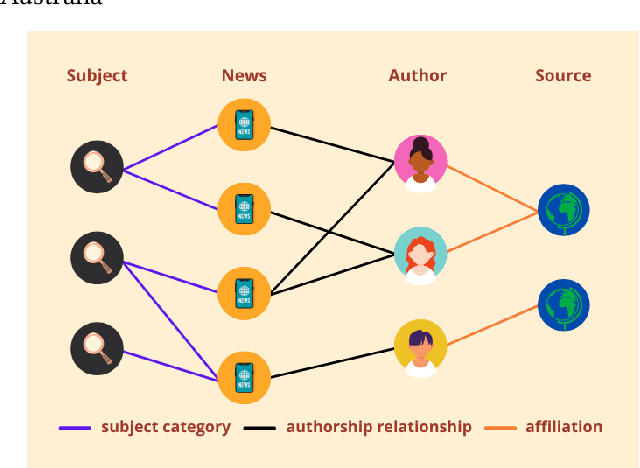
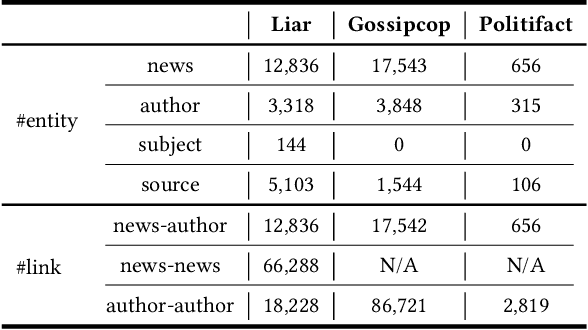
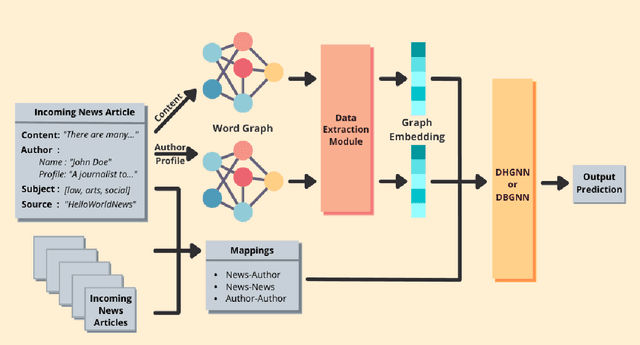

Abstract:The spread of fake news has caused great harm to society in recent years. So the quick detection of fake news has become an important task. Some current detection methods often model news articles and other related components as a static heterogeneous information network (HIN) and use expensive message-passing algorithms. However, in the real-world, quickly identifying fake news is of great significance and the network may vary over time in terms of dynamic nodes and edges. Therefore, in this paper, we propose a novel Dynamic Heterogeneous Graph Neural Network (DHGNN) for fake news quick detection. More specifically, we first implement BERT and fine-tuned BERT to get a semantic representation of the news article contents and author profiles and convert it into graph data. Then, we construct the heterogeneous news-author graph to reflect contextual information and relationships. Additionally, we adapt ideas from personalized PageRank propagation and dynamic propagation to heterogeneous networks in order to reduce the time complexity of back-propagating through many nodes during training. Experiments on three real-world fake news datasets show that DHGNN can outperform other GNN-based models in terms of both effectiveness and efficiency.
Variational Co-embedding Learning for Attributed Network Clustering
Apr 15, 2021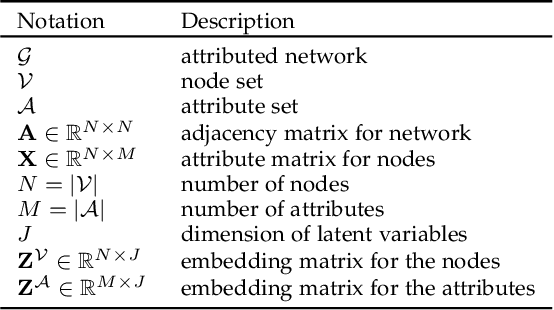


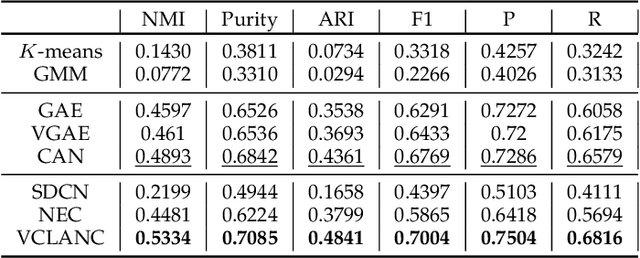
Abstract:Recent works for attributed network clustering utilize graph convolution to obtain node embeddings and simultaneously perform clustering assignments on the embedding space. It is effective since graph convolution combines the structural and attributive information for node embedding learning. However, a major limitation of such works is that the graph convolution only incorporates the attribute information from the local neighborhood of nodes but fails to exploit the mutual affinities between nodes and attributes. In this regard, we propose a variational co-embedding learning model for attributed network clustering (VCLANC). VCLANC is composed of dual variational auto-encoders to simultaneously embed nodes and attributes. Relying on this, the mutual affinity information between nodes and attributes could be reconstructed from the embedding space and served as extra self-supervised knowledge for representation learning. At the same time, trainable Gaussian mixture model is used as priors to infer the node clustering assignments. To strengthen the performance of the inferred clusters, we use a mutual distance loss on the centers of the Gaussian priors and a clustering assignment hardening loss on the node embeddings. Experimental results on four real-world attributed network datasets demonstrate the effectiveness of the proposed VCLANC for attributed network clustering.
 Add to Chrome
Add to Chrome Add to Firefox
Add to Firefox Add to Edge
Add to Edge